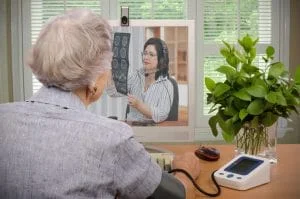 Even though the days of the common house call are long gone, for many patients traveling to see a doctor can be a challenge. Seniors face personal mobility issues and transportation hurdles that often prevent them from getting the care they need.
Even though the days of the common house call are long gone, for many patients traveling to see a doctor can be a challenge. Seniors face personal mobility issues and transportation hurdles that often prevent them from getting the care they need.
TeleHealth is an exciting opportunity for an aging population to receive adequate care without the worry of how they’ll travel to the doctor’s office. Senior living communities who integrate TeleHealth into their facilities offer their residents a valuable resource that keeps them active and engaged.
What is TeleHealth?
Sometimes referred to as telemedicine or digital health, TeleHealth uses a number of technologies and devices to connect patients with their healthcare providers. Remote appointments, biofeedback sensors, and other connected devices are used for sharing information between patients and physicians who can now remotely share their expertise.
The Benefits of TeleHealth
One of the biggest contributors to rising healthcare costs is the increased rates hospitals and doctors charge for visits and tests at their facilities. TeleHealth solutions can reduce costs while enhancing health outcomes by:
- Improving management of chronic diseases.
- Sharing health professional staffing.
- Reducing travel times.
- Reducing the number and length of hospital stays.
It should come as no surprise that TeleHealth is a rapidly growing component of healthcare in the U.S., with older adults enthusiastically embracing wearables and mobile health applications to monitor their weight, diet, exercise, blood glucose, sleep patterns, blood pressure, chronic pain, and more. Digital healthcare lets them stay connected to support mechanisms while living more productive, enjoyable lives.
TeleHealth and Senior Living
TeleHealth technologies will become a way of life for millions of baby boomers, 10,000 of whom are turning 65 every single day. Figuring out how to support their healthcare needs is crucial because they are managing more chronic conditions such as diabetes. And while one in four Americans deals with multiple chronic conditions that limit their daily activities, the number rises to three in four Americans aged 65 and older.
TeleHealth platforms encompass a wide variety of technologies:
- Mobile devices
- Audio-video linkups
- Wearable devices
- Connected devices
With most trips or transfers to hospitals unnecessary, TeleHealth solutions in your senior living facility offer residents improved safety, care, comfort, and convenience they may not find elsewhere. It’s especially attractive to seniors who are living in areas that aren’t close to medical facilities or hospitals.
With all these benefits, why then are so few senior living facilities using a TeleHealth platform to connect residents to outside healthcare services? Much of it has come down to healthcare plans not covering the services for independent living or assisted living communities. The good news is that as of 2020, Medicare Advantage plans will be permitted to cover TeleHealth Services delivered to senior living facilities.
Is Your Facility Ready?
TeleHealth programs need proper broadband to handle the service. Without it, you face the risk of dropped conferences, out-of-sync audio, and frozen video. Four factors define the high-quality connectivity needed: provider and equipment reliability, security, sufficient speed, and affordability.
Senior living and continuing care retirement communities should expect to see TeleHealth become much more prominent in the coming years. Crucial to its success will be consistent, high-quality connectivity.
HealthSignals’ Medical Grade Wi-Fi® is a future proof solution that offers reliable and secure campus wide WiFi and cellular coverage and ensures your residents have 24/7 access to top medical care at their fingertips.
Contact HealthSignals today to learn more.
